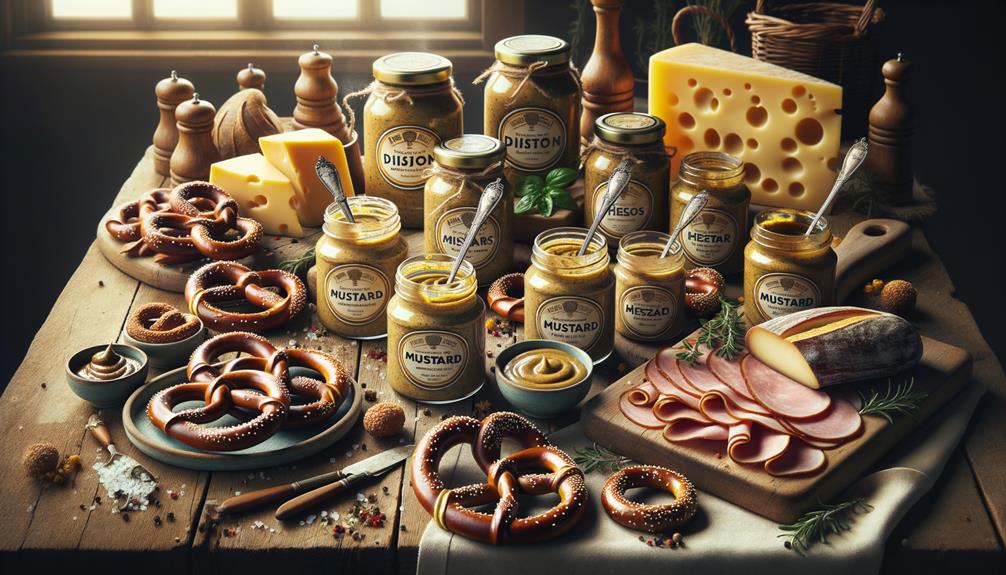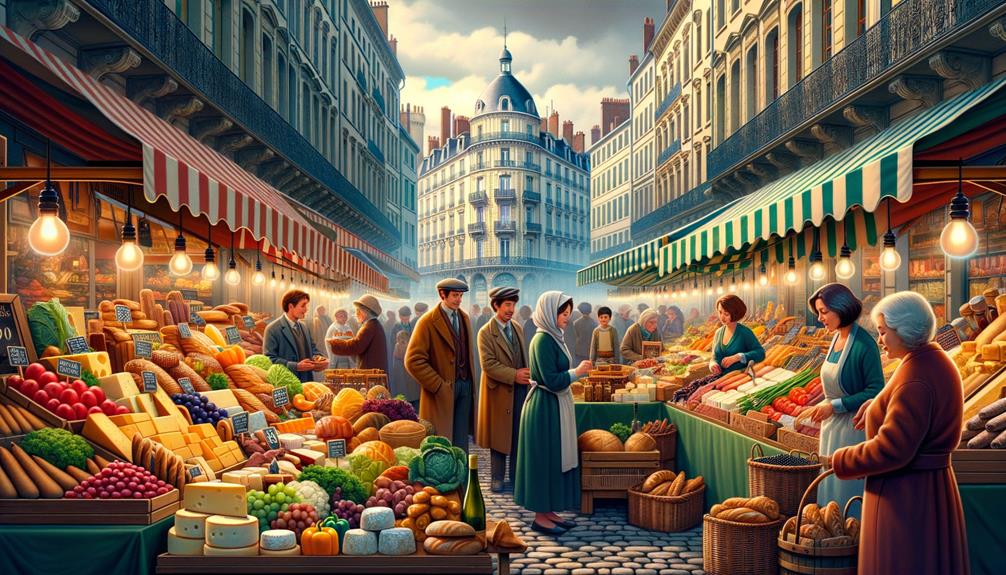When I started my Dijon mustard tasting journey, my first stop was Edmond Fallot's mustard mill. The air was filled with the rich scent of freshly ground mustard seeds, and I could see how each variety balanced tradition and new ideas. From honey-infused blends to truffle flavors, the selection was impressive. Tasting each one revealed its own unique complexity, making me appreciate the craftsmanship involved. It wasn't just about tasting; it was a deep dive into culinary history. What really stood out were the surprising flavor combinations that awaited me.
History of Dijon Mustard
Dijon mustard has been a staple of French cuisine since the 13th century. Its rich history is closely tied to the Dukes of Burgundy, whose motto, "Moult me tarde" ("Much I desire"), is the root of the French word for mustard, "moutarde." This connection highlights just how important Dijon mustard has been to the region.
What's amazing is that mustard makers in Dijon have been under regulation since 1390, ensuring their product's quality and authenticity long before modern food standards came into play. This commitment to excellence reflects the French passion for their culinary traditions.
Today, Dijon mustard enjoys protected geographical status, which underscores the unique methods and quality of mustard-making in Burgundy. This special recognition ensures that the tradition and flavor of Dijon mustard remain unique to its region, making it a culinary treasure that has delighted taste buds for centuries. The history of Dijon mustard is not just about a condiment but a journey through time, culture, and flavor.
Edmond Fallot Mustard Mill

When I visited the Edmond Fallot Mustard Mill, I was immediately struck by their traditional production methods using a stony grindstone. The authenticity of their process is tangible, and it comes through in their unique flavors like honey and pain d'épice mustard. Tasting these diverse mustards was a rich, sensory experience that showcased the meticulous care and expertise behind each jar.
Traditional Mustard Production
It's really something to see how the Edmond Fallot Mustard Mill sticks to tradition by stone grinding mustard seeds, ensuring each batch keeps its genuine flavors. Walking through this historic factory, I was captivated by their careful process. The dedication to preserving the taste of their mustard is truly inspiring.
Watching the stone grinding, I noticed how it adds a unique texture and depth to the mustard. This method isn't just a nod to the past; it genuinely affects the flavor, making each bite special. The Edmond Fallot Mustard Mill is a testament to the beauty of traditional craftsmanship in today's world.
Here are some interesting points about their production:
- Stone Grinding: Keeps flavors genuine and strong.
- Variety of Flavors: Includes honey, basil, tarragon, and more.
- Mustard Pots: Allows you to sample different types.
- Pain d'épice Mustard: A unique specialty from Dijon.
- Historical Significance: A living museum of mustard production.
The commitment to tradition at Edmond Fallot is more than just honoring the past; it's a celebration of the art and science of mustard making. This mustard factory is a haven for anyone who values culinary heritage and the freedom to explore different flavors.
Mustard Tasting Experience
When I walked into the tasting room at the Edmond Fallot Mustard Mill, I was immediately greeted by a colorful array of mustard pots, each hinting at a unique flavor waiting to be discovered. The room was filled with the inviting aroma of freshly ground mustard seeds, showcasing Moutarderie Fallot's commitment to traditional techniques.
Sampling the various mustards was a treat for my taste buds. Each variety, from honey to basil to tarragon, brought its own twist to the classic condiment. The highlight for me was the mustard mixed with pain d'épice, a specialty from Dijon. Its sweet and spicy notes added a surprising depth that I found both intriguing and delightful.
Watching the craftsmen work with grindstones, I gained a deeper appreciation for the meticulous process behind each jar. This traditional grinding method not only preserves the mustard's flavor but also connects us to a rich heritage of authentic craftsmanship.
Moutarderie Fallot offers more than just a mustard tasting; it provides an experience steeped in tradition, quality, and authenticity. Each flavor tells a story of dedication and passion, reflecting an unwavering commitment to excellence.
Moutarde Maille Dijon
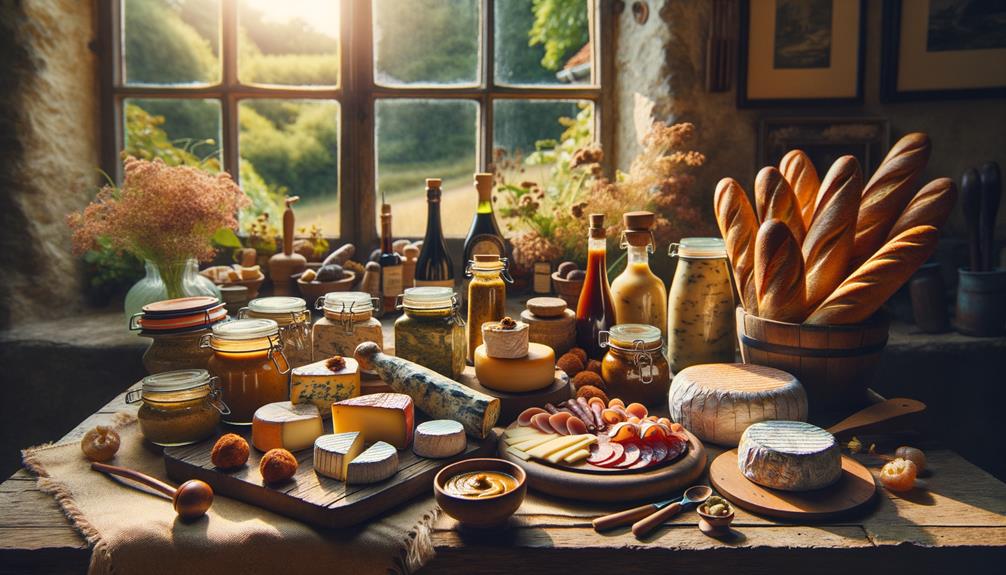
Walking into the Maille boutique in Dijon, I'm instantly taken by the rich smell of mustard that fills the air, hinting at a flavorful journey ahead. This famous shop at 32 Rue de la Liberté beckons me to check out its variety of mustards. Each jar and sample reflects a blend of tradition and creativity, a true mark of Maille since it started in 1747.
This isn't just any store—it's a paradise for mustard lovers. Here, I find:
- Free mustard samples that let me taste the detailed flavors.
- Limited edition mustards with unique takes on classic recipes.
- Truffle-infused olive oil to add a touch of luxury to my cooking.
- Stylish stoneware mustard pots, perfect as souvenirs or gifts.
- Draught mustard, freshly served from the pump for an unmatched taste.
Maille's dedication to blending innovation with traditional methods shines in every item. Their truffle, honey, and balsamic mustards show their skill in crafting diverse flavors. As I enjoy these gourmet options, I feel connected to Dijon's rich culinary history.
Mustard at Musée De La Vie Bourguignonne
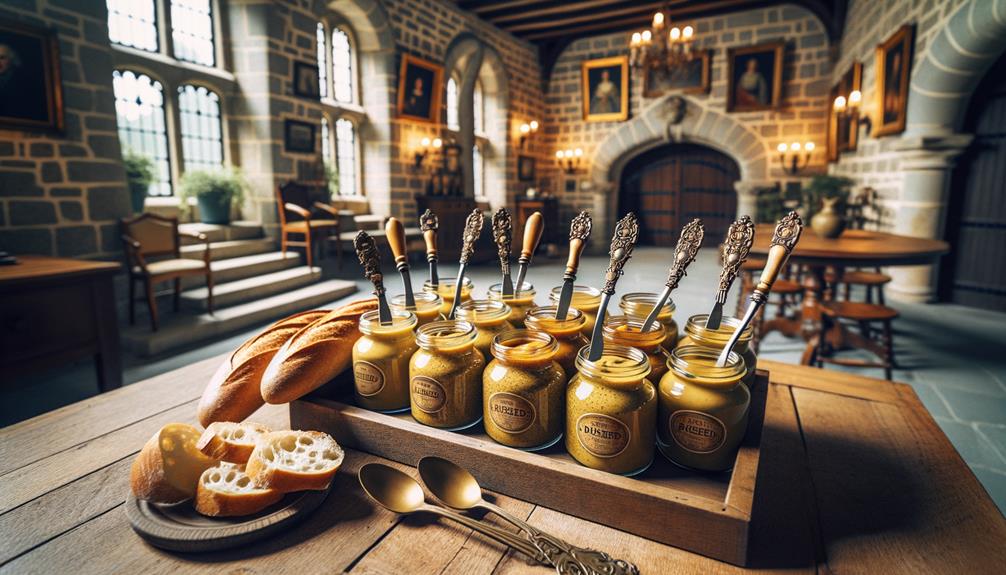
After leaving the aromatic haven of the Maille boutique, I made my way to the Musée De La Vie Bourguignonne, where mustard's rich history is showcased in a captivating exhibition. The museum, housed in a former convent, offers a delightful trip back in time with its replica storefronts and interiors from the 18th century. As I stroll through the displays, I'm amazed by the variety of mustard pots, each one a testament to the artistry and tradition rooted in Burgundy's culinary heritage.
The mustard exhibition is a goldmine for anyone curious about the condiment's origins and importance. Detailed displays illustrate the evolution of mustard-making techniques, highlighting its crucial role in the region's cuisine. Understanding the careful process behind each jar of Dijon mustard makes me appreciate the craftsmanship even more.
Next to the mustard exhibition, the Musée d'Art Sacré provides a peaceful and reflective space, enriching the overall experience. The combination of culinary and sacred art creates a unique atmosphere, encouraging contemplation of Burgundy's cultural wealth. This museum visit isn't just about mustard; it's a deep dive into the region's vibrant history.
Mustard Tasting in Beaune
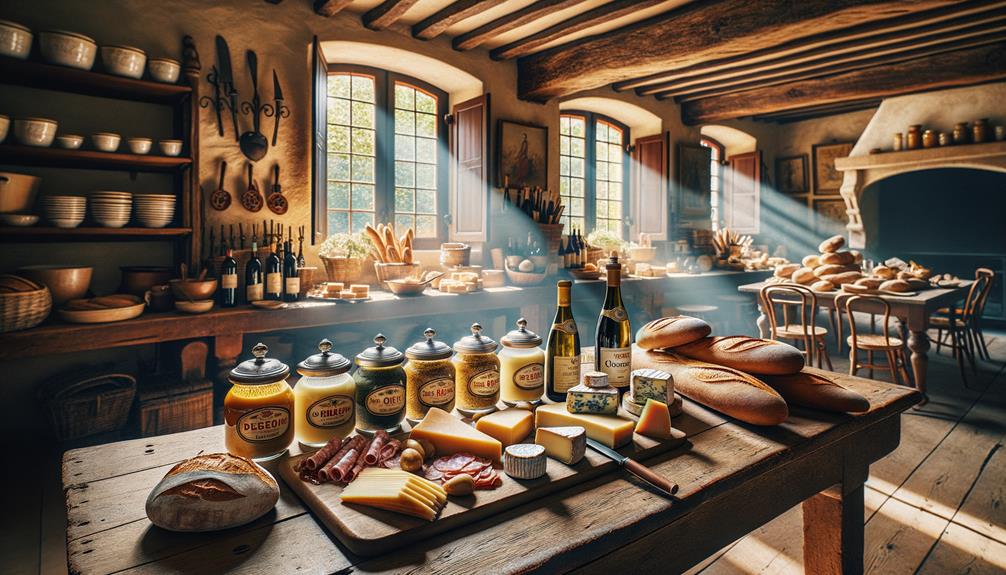
While in Beaune, I visited a historic mustard factory that gave me a real feel for Burgundy's rich mustard-making tradition. The tasting bar was a highlight, offering a variety of flavors that showcased the subtle differences between each type. The beautiful surroundings added to the experience, deepening my appreciation for this regional specialty.
Historic Mustard Factory Tour
The historic mustard factory in Beaune offers a fascinating look into both modern and traditional ways of making mustard, enriched by the culinary heritage of the Burgundy region. Walking into the factory, you can almost feel the history blending with the hum of contemporary machinery. The air is thick with the aroma of mustard seeds and vinegar, a testament to the careful attention given to each jar of Edmond Fallot mustard.
As you stroll through the production lines, you see mustard grains being crushed and mixed, a process that has stayed much the same for centuries. The combination of old-world craftsmanship and modern efficiency is truly captivating. Here are some highlights that made the tour stand out:
- Historic Techniques: Learning about time-honored methods of making mustard.
- Modern Production: Seeing cutting-edge machinery at work.
- Expert Insights: Chatting with mustard experts who shared their knowledge and enthusiasm.
- Culinary Heritage: Experiencing the rich traditions of Burgundy.
- Edmond Fallot: Getting to know the story behind the brand.
This tour isn't just a walk through a factory; it's a journey through time and taste, giving you a deeper appreciation for the mustard that's found its way into kitchens around the world.
Diverse Mustard Flavor Sampling
Stepping into the tasting room at Edmond Fallot in Beaune, I was immediately drawn to the vibrant mustard flavors on display, like honey, basil, and tarragon. Each jar seemed to offer a unique adventure for my taste buds, all rooted in the rich heritage of Dijon mustard seeds.
As I sampled these varieties, I was captivated by the delicate balance of sweetness and spice in the honey mustard, while the basil-infused version delivered a fresh, herbaceous twist. The tarragon mustard, on the other hand, provided a sophisticated, aromatic experience that lingered beautifully on my palate.
Here's a quick comparison of some standout flavors:
| Flavor | Key Ingredient | Tasting Notes |
|---|---|---|
| Honey | Dijon mustard seeds | Sweet, mildly spicy |
| Basil | Dijon mustard seeds | Fresh, herbaceous |
| Tarragon | Dijon mustard seeds | Aromatic, sophisticated |
Continuing my exploration, I stumbled upon the unique pain d'épice mustard, a specialty from Dijon that blends warm spices and mustard seeds. And who could overlook the truffle-infused mustards at Maille? These added a luxurious depth to the tasting experience. The chic stoneware pots from Maille also caught my eye, perfect for gifting or adding a touch of elegance to my own kitchen. This rich mustard culture in Beaune and Dijon truly showcases the artistry and versatility of mustard seeds.
Interactive Tasting Bar Experience
When I walked into the interactive tasting bar in Beaune, I was immediately drawn to the colorful array of mustard jars, each offering a unique flavor journey. The room was filled with the rich scents of mustard seeds and spices, making it a sensory delight. It was amazing to see how Dijon's famous mustard had been transformed into an art form here.
This wasn't just about tasting mustard; it was about diving deep into its world. The variety of flavors and textures available for sampling was incredible. From classic to modern twists, each jar had its own story to tell about the evolution of mustard-making.
- Traditional Dijon Mustard: The classic, smooth with a sharp tang.
- Honey Mustard: A sweet and spicy blend that was perfectly balanced.
- Herb-Infused Mustard: Earthy notes that added complexity to the taste.
- Blackcurrant Mustard: A surprising mix of sweet and savory.
- Truffle Mustard: Rich and luxurious with a hint of umami.
Tasting each one, I gained a newfound appreciation for the craftsmanship behind these unique flavors. The tasting bar not only showed off the diversity of mustard but also deepened my understanding of how it's made. This interactive experience in Beaune celebrated Dijon's heritage and welcomed new innovations.
Different Mustard Varieties

Trying different Dijon mustards is like taking a flavorful journey. You can taste the gentle sweetness of honey mustard or the aromatic kick of tarragon-infused blends. One variety that really stood out to me was Burgundy mustard, which pays homage to the region's famous wine. It's got a strong, sophisticated flavor that's perfect for anyone who loves depth and complexity.
Another unique option is mustard with pain d'épice. This special blend combines the bold taste of mustard with the warm, spiced notes of gingerbread, creating a nostalgic yet innovative flavor. Pain d'épice mustard showcases Dijon's rich culinary heritage by blending local flavors into a harmonious mix.
Maille, a well-known mustard brand, pushes the boundaries with versions like truffle, honey, and balsamic. Their honey mustard strikes a nice balance between sweet and tangy, while the truffle one brings a luxurious, earthy depth. Edmond Fallot, another respected name, sticks to traditional stone grinding to create unique flavors like basil and tarragon. The basil mustard is fresh and herbaceous, great for summer dishes, and the tarragon variety has a fragrant, slightly anise-like finish.
Each variety brings something special, highlighting the vibrant and diverse world of Dijon mustard.
Homemade Mustard Tips
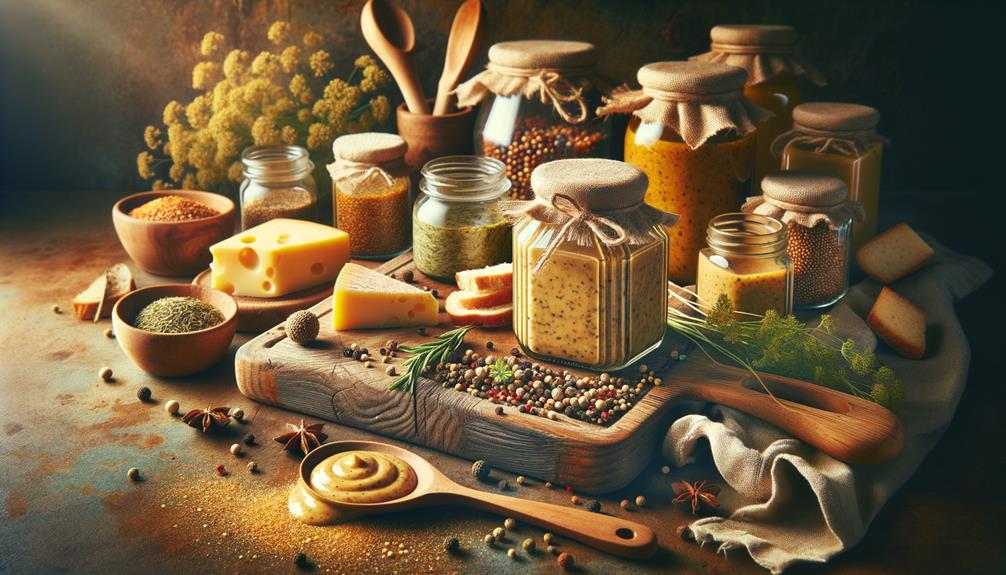
Making your own mustard is a fun and creative way to get the exact flavor you want. When I first tried it, I was amazed at how simple and flexible it was. With basic ingredients like mustard seeds, wine, vinegar, and salt, you can make a mustard that's perfect for your taste. The Tourist Office and Edmond Fallot in de Bourgogne offer great tips for beginners, ensuring a satisfying experience.
One of the main things to focus on is the ingredients. Using good-quality mustard seeds and a nice wine or vinegar can really make a difference. Trying out different kinds of mustard seeds and liquids can give you some surprising and tasty results.
Here are some tips for making your homemade mustard:
- Grind and crush: Use a mortar and pestle or a spice grinder to get the texture you like.
- Season to taste: Adjust the salt and other spices to your preference.
- Mix thoroughly: Make sure all the ingredients are well combined.
- Chill after making: Putting it in the fridge helps bring out the flavors.
- Experiment: Don't hesitate to try new ingredient combinations.
Making mustard at home is not just about the final product; it's also about enjoying the process and creating something uniquely yours.
Frequently Asked Questions
What Does Dijon Mustard Taste Like?
Dijon mustard has a tangy and sharp flavor, perfectly balancing spiciness and acidity. You'll notice hints of white wine, vinegar, and spices, which blend together smoothly, making it a versatile condiment.
Is Dijon Worth Visiting?
Dijon is definitely worth a visit. I was amazed by its blend of historical charm and culinary delights. The city's vibrant culture, stunning architecture, and rich traditions offer an immersive and unforgettable experience for any traveler.
Why Is There a Shortage of Dijon Mustard?
Think about the tangy, rich flavor of Dijon mustard disappearing from your table. This shortage comes from poor mustard seed harvests, rising global demand, and strict quality standards. These factors together create a situation where supply can't keep up with demand.
Why Is Dijon Mustard so Expensive?
I've noticed Dijon mustard tends to be pricey because it's made with high-quality ingredients and follows traditional methods. The limited production and artisanal techniques, plus its reputation as a gourmet item, really drive up the cost. It's all about the quality and craftsmanship.

